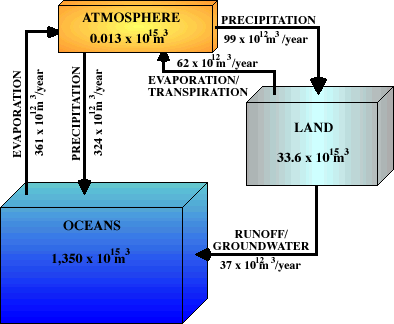Water covers 70% of the earth's surface, but it is difficult to comprehend the total amount of water when we only see a small portion of it. The following diagram displays the volumes of water contained on land, in oceans, and in the atmosphere. Arrows indicate the annual exchange of water between these storages.

Diagram adapted from: Peixoto and Kettani (1973)
The oceans contain 97.5% of the earth's water, land 2.4%, and the atmosphere holds less than .001%, which may seem surprising because water plays such an important role in weather. The annual precipitation for the earth is more than 30 times the atmosphere's total capacity to hold water. This fact indicates the rapid recycling of water that must occur between the earth's surface and the atmosphere.
To visualize the amount of water contained in these storages, imagine that the entire amount of the earth's annual precipitation fell upon the state Texas. If this was to occur, every square inch of that state would be under 1,841 feet, or 0.3 miles of water! Also, there is enough water in the oceans to fill a five-mile deep container having a base of 7,600 miles on each side.

introduction |
|

evaporation |